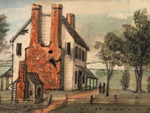Fort Boonesborough State Park [KY]
Fort Boonesborough was originally built in 1775 by Daniel Boone and his men to serve as a frontier outpost along the Kentucky River. Today, the fort has been completely reconstructed and functions as a living history museum, giving modern-day visitors a sense of what life was like for pioneers in Kentucky. In addition to the reconstructed fort, the park contains the Kentucky River Museum, which provides visitors with "insight into the lives of families who lived on the river and worked the locks and dams in the 1900s."
The park offers exhibits, tours for school groups, living history demonstrations, special school days throughout the year, and other educational and recreational events. The website offers visitor information, a photo gallery featuring 13 photographs of the park, and an events calendar.
